oil AUDI A8 2013 User Guide
[x] Cancel search | Manufacturer: AUDI, Model Year: 2013, Model line: A8, Model: AUDI A8 2013Pages: 318, PDF Size: 79.34 MB
Page 209 of 318
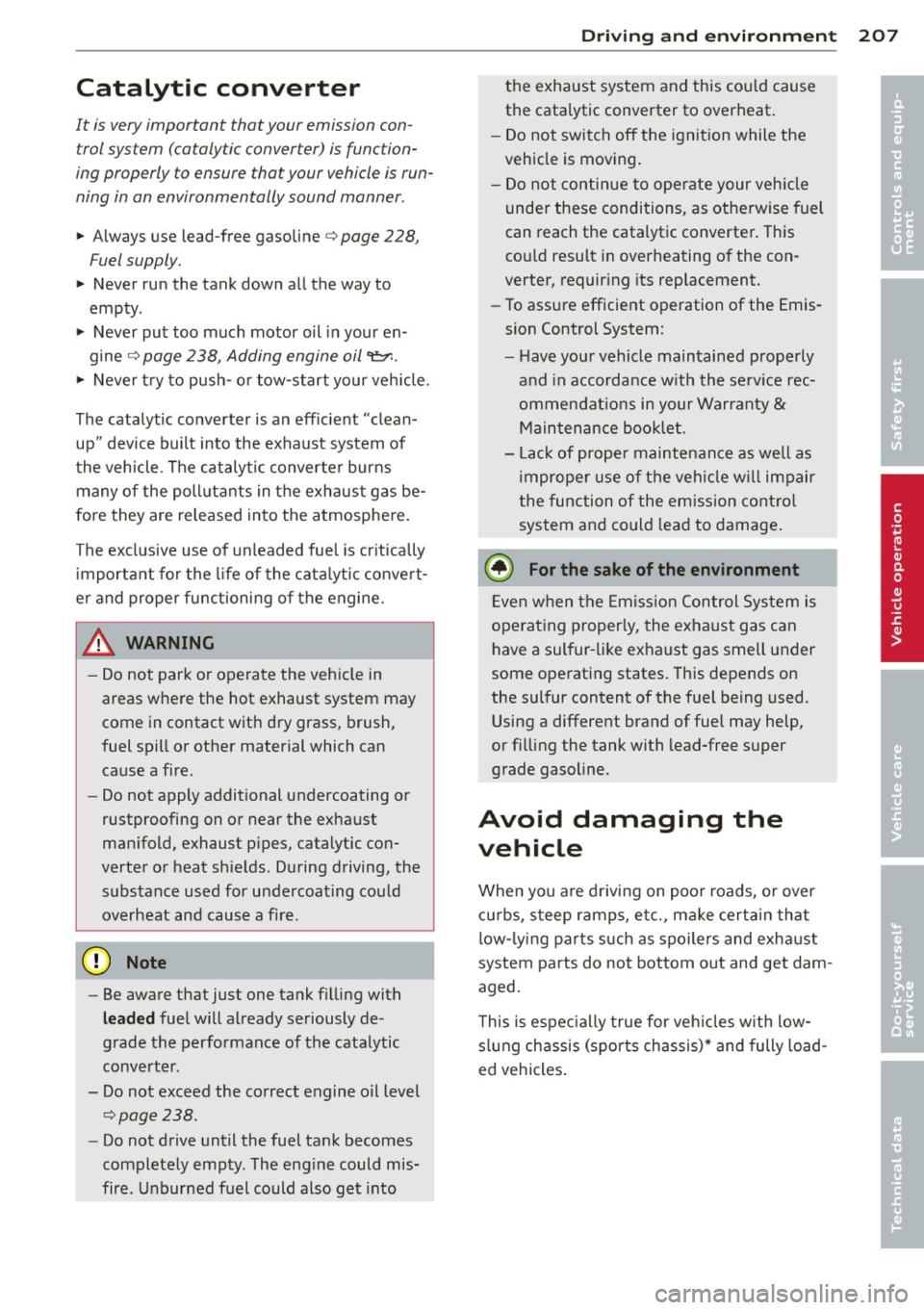
Catalytic converter
It is very important that your emission control system (catalytic converter) is function
ing properly to ensure that your vehicle is run
ning in an environmentally sound manner .
.. Always use lead-free gasoline¢ page 228,
Fuel supply.
.,. Never run the tank down all the way to
empty.
.,. Never put too much motor oil in your en-
gine ¢
page 238, Adding engine oil~-
.,. Never try to push- or tow-start your veh icle.
The catalytic converter is an eff icient "clean
up" device built into the exhaust system of
the vehicle . The catalytic converter burns
many of the pollutants in the exhaust gas be
fore they are released into the atmosphere.
The exclusive use of unleaded fuel is critically
importa nt for the life of the cata lytic convert
e r and proper functioning of the engine.
A WARNING
-
- Do not park or operate the vehicle in
areas where the hot exhaust system may
come in contact with dry grass, brush,
fuel spill or other material which can cause a fire.
- Do not apply additional undercoating or
rustproofing on or near the exhaust
man ifold, exhaust pipes, catalytic con
verter or heat shields. During driving, the
substance used for undercoating cou ld
overheat and cause a fire.
0 Note
- Be aware that just one tank filling with
leaded fuel will already seriously de
grade the performance of the catalytic
converter.
- Do not exceed the correct engine oil level
¢ page 238.
-Do not drive until the fuel tank becomes
completely empty. The eng ine could mis
fire . U nburned fuel could a lso get i nto
Dri vin g and en vironm ent 207
the exhaust system and this cou ld cause
the catalytic converter to overheat .
- Do not swi tch off the ignit ion while the
vehicle is mov ing.
- Do not continue to ope rate your veh icle
unde r these conditions, as othe rwise fuel
can reach the catalytic converter. This
co uld result in overheating o f the con
verter, requir ing its replacement .
- To assure efficient operation of the Emis
sion Control System:
- H ave your vehicle maintained prope rly
and in accordance w ith the se rv ice rec
ommendat ions in you r Warranty &
M aintenance boo klet.
- L ack of prope r maintenance as we ll as
improper use of the vehi cle w il l impair
the function of the em ission contro l
system and could lead to damage .
@ For the sake of the environment
Even when the Emiss ion Control System is
operat ing properly, the exha ust gas can
have a sul fur -li ke exhaust gas smell under
some operating states . This depends on
the sulfur content of the fuel being used .
Using a different brand of fue l may help,
or filling the tank with lead-free super
grade gasoline .
Avoid damaging the
vehicle
When you are drivi ng on poo r roads, or over
c ur bs, s teep ramps, etc., ma ke certai n that
low -lying parts s uch as spoilers and exhaust
system pa rts do not bottom o ut and get dam
aged.
T h is is espec ially true for veh icles w ith low
s lung chassis (spor ts chassis)* and fully load
ed vehicles. •
•
Page 211 of 318

Avoid full throttle
Driving at moderate speeds saves fuel and
improves your mileage.
11-Try and keep well below your car's maxi-
mum speed.
Accelerating gently reduces fuel consump tion, engine wear, and does not disturb the
environment.
F ue l consumption, exhaust emissions and en
g ine noise increase disproportionately at high
speeds. If you drive at approximately three
quarters of top speed, fuel consumption will
be reduced by one half. Never drive faster
than the posted speed limit and weather con
d itions permit .
Reducing unnecessary idling
Even when your car is just idling it burns up
fuel.
11-Shut the engine off when you are not driv
ing the vehicle.
"" Do not warm up the veh icle by letting the
engine run at idle .
The idling phase is automat ically reduced for
vehicles w ith the Start/Stop system . It is effi
cient to switch
off the engine in vehicles with
out the Start-Stop-System when stopped at ra il road crossings and long red lights. Turning
the eng ine
off for just 30 -40 seconds saves
mo re fuel than is burned by s tarting the en
gine again.
It takes a long time fo r the engine to wa rm up
fu lly when it is running at idle. Howeve r, wear
and noxious emissions are especially high
when the engine is warming up. So you should
drive away as soon as you start the engine and
avoid running at h igh rpms while the engine is
still warming up.
CD Note
Do not leave engine idling unattended af
ter starting. If warning lights shou ld come
on to indicate improper operation, they
Dri vin g and en vironm ent 209
would go unheeded. Extended idling a lso
produces heat, which could result in over
heating or other damage to the veh icle or
other property.
Regular maintenance
A badly tuned engine unnecessarily wastes a lot of fuel.
11-Have your vehicle serviced at reg ular inter-
vals .
By having your ve hicle reg ularly se rviced by an
Audi dealer he lps to ensure that it runs prop
erly and economically . The condition of your
vehicle not only affects its safety and ability to
ho ld its va lue, it also affects
fuel co nsump
tion .
Chec k your oil e ach t ime you fill y our t ank.
T he amou nt of o il used is re lated to engine
load and speed.
It is normal for the oil consumption of a new
engine to reac h its lowest value after a certa in
mileage has bee n driven.
You must drive your veh icle about 3,000 m iles
(5,000 kilometers) before you can properly
assess oil consumpt ion.
This also applies to fuel consumption and en gine output .
CD Note
-Have your veh icle ma inta ined properly
and in accordance with the service rec
ommendations in your Warranty
& Ma in
tenance book let . Lack of proper mainte
nance as well as improper use of the ve
hicle will impai r the function of the
em ission cont ro l system and cou ld lead
t o damage.
- Do not alter or remove any component of
t he Emission Control System unless ap
proved by the manufacture r.
- Do not alter or remove any devi ce, such
as heat shie lds, switches, ign ition w ires,
valves, which are designed to protect
your vehicle's Emission Control System
•
•
Page 218 of 318
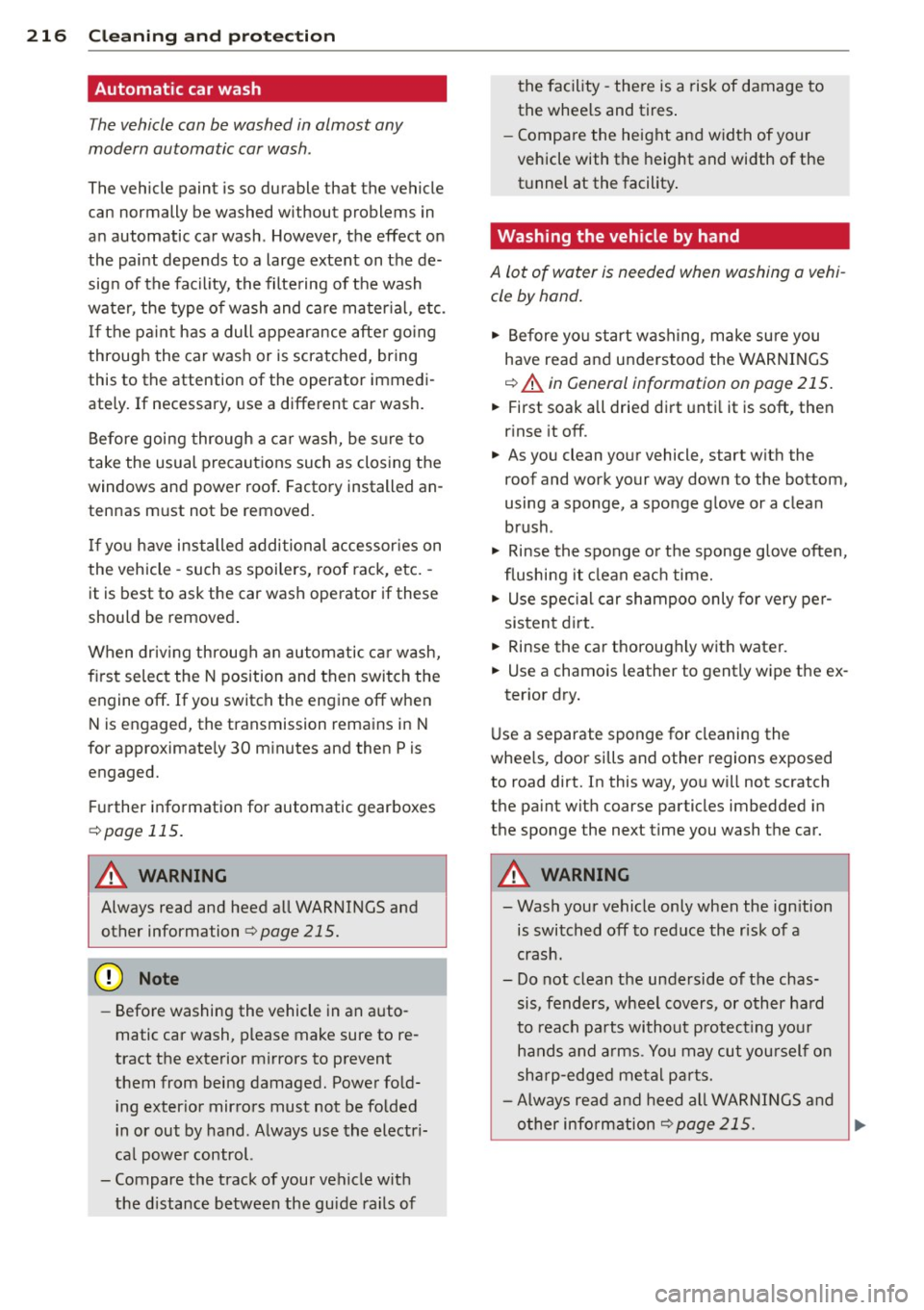
216 Cleaning and protec tio n
Automatic car wash
The vehicle can be washed in almost any
modern automatic car wash .
The vehicle paint is so durable that the vehicle
can normally be washed without problems in
an automatic car wash. However, the effect on
the paint depends to a large extent on the de
sign of the facility, the filte ring of the wash
water, the type of wash and care mater ial , etc.
I f the pa int has a dull appearance afte r going
through the car wash or is scratched, bring
this to the attention of the operator immedi
ately. If necessary, use a different car wash.
Before going through a car wash, be sure to
take the usual precautions such as closing the
windows and power roof . Factory installed an
tennas must not be removed.
I f you have installed additional accessor ies on
the vehicle - such as spoilers, roof rack, etc. -
it is best to ask the car wash operator if these
should be removed .
When driving through an automatic car wash,
fi rst se lect the N position and then switch the
engine off. If you switch the engine off when N is engaged, the transmission remains in N
for approximately 30 m inutes and then Pis
engaged.
Further information for automatic gearboxes
~ page 115.
A WARNING
Always read and heed all WARNINGS and
other information
r:::;, page 215.
- Before washing the vehicle in an auto
matic car wash, p lease make sure to re
tract the exterior mirrors to prevent
them from being damaged. Power fold i ng exter ior mirrors must not be folded
i n or out by hand . Always use the electri
ca l power control.
- Compare the track of your vehicle with the d istance between the guide rails of the facility - the
re is a risk of damage to
the whee ls and tires .
- Compare the height and width of your
vehicle with the height and width of the tunnel at the facility .
Washing the vehicle by hand
A lot of water is needed when washing a vehi
cle by hand.
.,. Before yo u start washing, make su re you
have read and understood the WARNINGS
~ A in General information on page 215.
.,. First soak all dried dirt unti l it is soft, then
rinse it off.
.,. As you clean your vehicle, start with the
roof and work your way down to the bottom,
using a sponge, a sponge glove or a clean brush .
.,. Rinse the sponge o r the sponge g love often,
flushing it clean each time.
.,. Use spec ial car shampoo only for very per
sistent dirt .
.,. Rinse the car thoroughly with water.
.,. Use a chamois leather to gently wipe the ex-
ter ior dry.
Use a separate sponge for cleaning the
whee ls , door si lls and other regions exposed
to road dirt. In this way, you will not scratch
the pa int with coarse particles imbedded in
the sponge the next time you wash the car.
A WARNING
-- Wash your vehicle only when the ign ition
is switched off to reduce the risk of a
crash.
- Do not clean the underside of the chas sis, fenders, wheel covers, or other hard
to reach parts without protect ing your
hands and arms . You may cut you rself on
sha rp-edged metal pa rts.
- Always read and heed all WARNINGS and other info rmation
c;, page 215. ~
Page 219 of 318

(D Note
-Never try to remove dirt, mud or dust if
the surface of the vehicle is dry. Never
use a dry cloth or sponge, since this
could scratch your vehicle's pa int or w in
dows .
- Never wash your car in bright sunlight.
Drops of water act as magnifying lenses
and may damage your paint.
- When you wash your car in the w inter : if
you r inse your vehicle w ith a hose, be
careful not to aim the stream of water
direct ly at locks, or at door or hatch
openings - they can free ze shut.
- Never use sponges des igned to remove
i nsects, or any kitchen scouring sponges
or similar products. They can damage
you r paint finish .
- Never use a dry cloth o r sponge to clean
the headligh ts. On ly use we t cloths or
sponges to prevent scratches .
It is best
to use soapy wate r.
- You sho uld remove debris (su ch as in
sects) from the head ligh t lenses on a
r egular basis, for example when refuel
ing your vehicle . Never clean the head
li ghts w ith a dry cloth or sponge. Use a
wet cloth or sponge. It is best to use
soapy water.
@ For the sake of the environment
On ly wash the vehicle in facilit ies specially
designed for that purpose. Th is w ill reduce
the risk of d irty water contaminated with
oil from entering the sewer system . In
some areas, wash ing vehicles outs ide of
these facilit ies is prohib ited.
Washing your vehicle with a power
washer
Cleaning the exterior of your car with a high
pressure power washer is safe as long as you observe a few simple rules .
~ Before usi ng the power washe r, make sure
yo u have re ad an d u nderstood the WARN-
Cleaning and protec tion 217
INGS ¢ A in General information on
page 215 .
~ Always follow the operating instr uctions for
the power washer.
~ Make sure that the jet on the spray hose
produces a "fan shaped spray" .
~ Do not hold the spray nozzle too close to
soft mater ials .
Keep a distance from soft materia ls suc h as
rubbe r hoses or insulating material as well as
senso rs and camera lenses .
When cleaning the vehicle with a power was h
er
always follow the operating instructions .
This applies part icu larly to the operati ng pres
su re and the spraying d istance . Do not point
the spray d irectly at the seals around the side
windows, around the doo rs, on t he rear lid or
o n the sunroo f*. L ikewise, do no t poi nt i t di
re ct ly a t tires, rubbe r hoses, insula tion mate
ria l or senso rs ~
page 218 . Hold the spray
nozzle at least 1.3 ft (0.4 m) away from the
vehicle.
Do no t use a high-pressure power was her to
remove snow and ice.
Do not use a jet which sprays wate r in a d irect
stream o r one that has a ro ta ti ng jet.
Water temperature should not exceed 140 °F
(60 °().
&_ WARNING
N eve r wash tires wi th a jet that sprays w a
ter in a direc t stream . T his co uld ca use in
v isi ble damage to the t ires and weaken
them, even i f the spray is from a re lative ly
l ong distance and for a sho rt time. Dam
aged and weakened tires can fail and cause
accidents and personal in jury.
Q) Note
To avoid damaging yo ur vehicle, a lways
make sure that there is suffic ient d istance
between the spray head and soft materia ls
lik e rubber hoses, plast ic parts a nd sound
deaden ing mater ia ls as well as sensors
and camera lenses . Never a im t he spray
head at the same point fo r a long time .
•
•
Page 221 of 318

headlight washer system (night vis ion as
sist*) .
If the area is heavily soi led, you can
clean it with glass clean ing agent and a soft,
dry cloth.
(D Note
- If you wash your vehicle with a pressure
washer,
- make sure there is enough d istance to
sensors in the rear bumper .
- do not clean the camera lenses and the area around them with the pressure
washer.
- Never use warm or hot water to remove
snow or ice from the camera lens . Th is
could cause the lens to c rac k.
- Neve r clean the came ra lens w it h abra
s ive p roducts.
Waxing and Polishing
Waxing
A good wax coat ing protects the ve hicle pa int
to a large extent aga inst the environmen tal
factors listed under
r::o page 215, Washing and
even against slight scratches .
You can use a liquid ca r wax to p rotect your
pa int as soo n as o ne week after your veh icle
h as been de livered .
Even if you regular ly use a
waxing process in
automatic ca r washes, we recommend t hat
you ma nually app ly a coat of wax to give the
pa int extra protec tion , particula rly if wate r no
l onge r beads on the clean paint .
P rotect p lastic body pa rts with ca r wax i n the
same way as the vehicle body.
During warm weather dead insects tend to
collect on the front bumper and on the for
ward area of the hood . They a re much easier
to remove from pai nt tha t is waxed
often.
Polishing
Poli sh your vehicle only if the pa int has lost its
shine and the gloss cannot be brought back
with wax .
Cleaning and protec tion 219
If the po lish used does not contain p reserva
tive compounds, the paint must be waxed af
terwards.
_& WARNING
A lways read and heed all WARNINGS and
other information
r::opage 215 .
([) Note
Do not use car wax on
- matte or anodized meta l trim
- ru bber or ru bber- lik e t rim.
Trim strips
Metal trim needs special care.
For environmental reasons, Audi fabric ates
the bright t rim strips and trim p ieces from
pure chromium-free al uminum .
Dirt and marks on the trim strips shou ld be
removed w ith a
pH-balanced cleaning agent
(do not use a chrome cleane r) . Aud i dealers
carry clean ing produc ts which have been test
ed fo r use on your vehicle and are not ha rmfu l
to the environment.
T o avoid co rrosion on the exter ior trim st rips,
o nly a pH-ba lanced solu tion should be used
for the windsh ield washer.
_& WARNING
A lways read and heed all WARN INGS and
o ther in formation
r::o page 215 .
Plastic and vinyl
Plastic needs special care.
Use a clean , damp cloth or sponge to remove
dust and light s urface di rt . For other soil, use
a lukewa rm all-p urpose cleaning so lution or a
mild saddle soap for v inyl tr im . Remove wate r
spots and traces of soa p wi th a cle an, d amp
clo th or sponge. Use a clean, so ft cloth to rub
dry .
G rease , ta r or oil stains can be removed w it h a
cl ea n clot h or sponge soake d wit h all- purpose .,.
•
•
Page 222 of 318
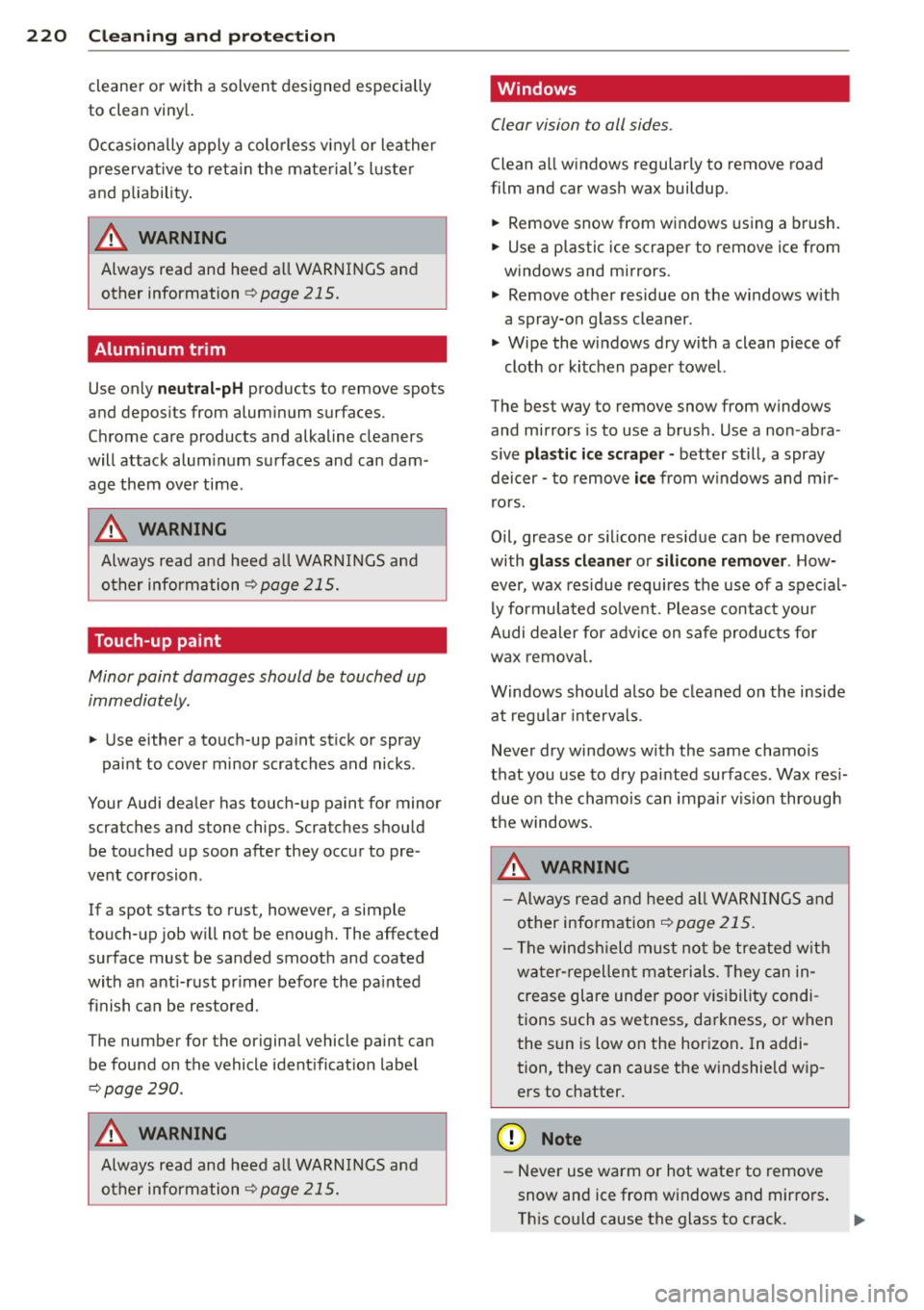
220 Cleaning and protec tio n
cleaner or with a solvent designed especially
to clean viny l.
Occasionally apply a colo rless v inyl or leather
preservat ive to reta in the material's l uste r
and p liability .
A WARNING
Always read and heed a ll WARNINGS and
other information
Q page 215.
Aluminum trim
Use only n eutr al- pH products to remove spots
and depos its from aluminum surfaces.
Chrome care products and alkaline cleaners
will attack alum inum surfaces and can dam
age them over time .
A WARNING
Always read and heed a ll WARNINGS and
other information
Q page 215.
Touch -up paint
Minor paint damages should be touched up
immediately .
.. Use either a touch-up pa int stick or spray
paint to cove r minor scratches and nicks .
Your Audi dealer has touch-up paint for minor scra tches and stone chips. Scratches should
be touched up soon after they occur to pre
vent corrosion .
If a spot starts to rust, however, a simple
touch-up job w ill not be enough. The affected
surface must be sanded smooth and coated
with an anti-rust pr imer befo re the pa inted
finish ca n be restored .
The number for the original vehicle paint can be found on the vehicle ident ificat ion label
Q page 290 .
A WARNING
Always read and heed a ll WARNINGS and
other information
Qpage 215.
Windows
Clear vision to all sides .
Clean all windows regula rly to remove road
film and car wash wax buildup.
.. Remove snow from w indows us ing a brush.
.. Use a plastic ice sc raper to remove ice from
w indows and mirrors.
.. Remove other residue on the windows with
a spray-on g lass cleaner .
.. Wipe the windows dry with a clean piece of
cloth or kitchen paper towel.
The best way to remove snow from windows and mirrors is to use a brush . Use a non-abra
s ive
plastic ic e scrape r -better st ill, a spray
deicer - to remove
ice from w indows and m ir
ro rs.
Oil , grease or s ilicone residue can be removed
with
gla ss cleaner or silicon e remover . How
ever, wax res idue requires the use of a spec ial
ly formula ted so lve nt. Please contact your
A udi dealer for adv ice on safe products for
wax removal.
Windows should also be cleaned on the inside at regu la r i nte rvals .
Never dry windows with the same chamo is
that you use to dry pai nted surfaces. Wax resi
due on the chamois can impa ir v is ion through
t h e windows.
A WARNING
- Always re ad and heed a ll WAR NINGS and
other info rmation
Q page 215.
- The windsh ield must no t be treated w ith
water-repellen t materials. They can in
crease glare unde r poo r vis ibility condi
tions such as wetness, darkness, or when
the sun is low on the horizon . In addi
tion, they can cause the w indshield w ip
ers to chatter.
(D Note
- Never use warm or hot water to remove
snow and ice from windows and mirrors .
Th is could cause the glass to crack. ..,_
Page 225 of 318
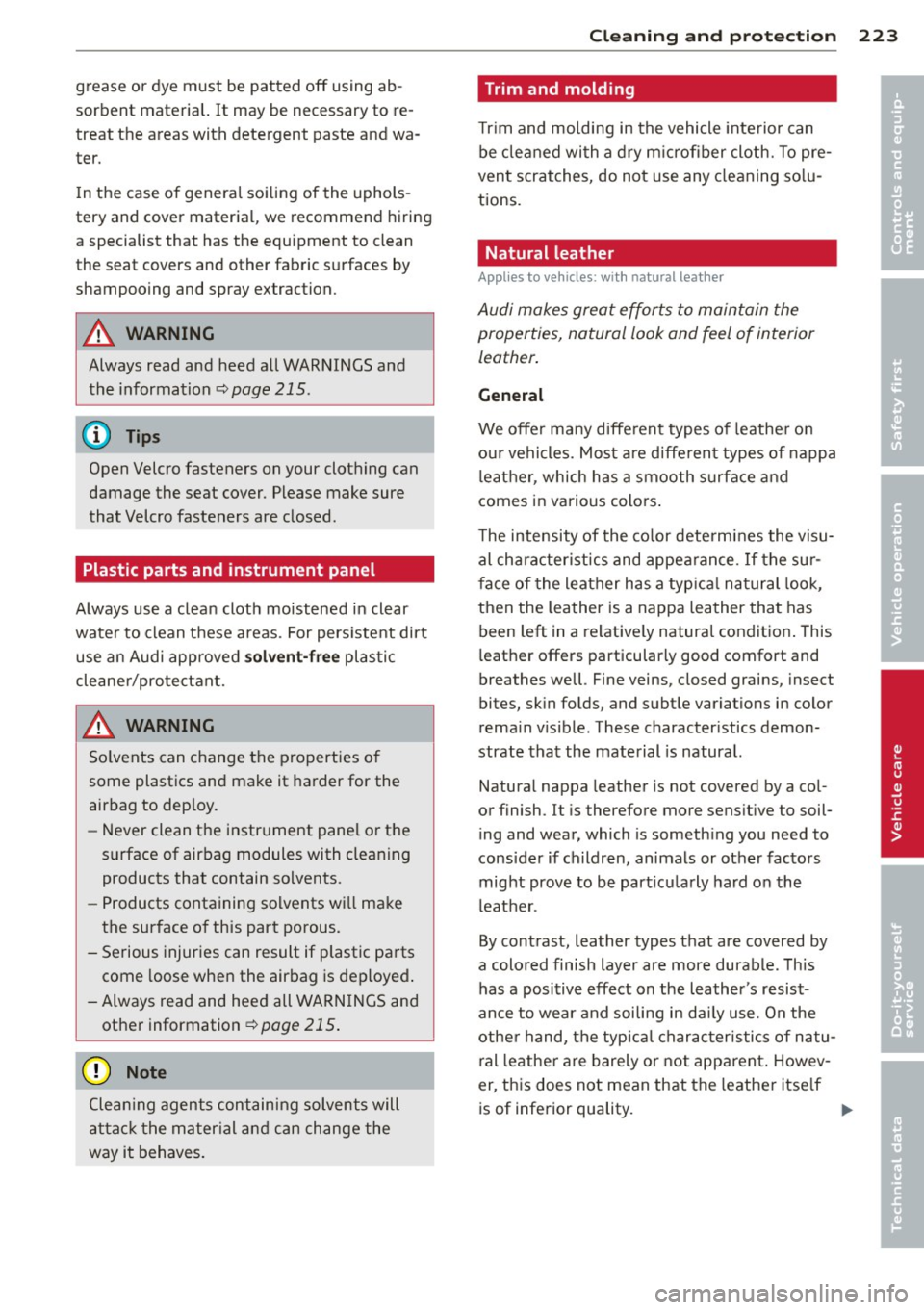
grease or dye must be patted off using ab
sorbent material. It may be necessary to re
treat the areas with detergent paste and wa
ter.
In the case of general soiling of the uphols
tery and cover material, we recommend hiring
a specialist that has the equipment to clean
the seat covers and other fabric surfaces by
shampooing and spray extraction.
A WARNING
Always read and heed all WARNINGS and
the information
Qpage 215.
Open Velcro fasteners on your clothing can
damage the seat cover. Please make sure
that Velcro fasteners are closed.
Plastic parts and instrument panel
Always use a clean cloth moistened in clear
water to clean these areas. For persistent dirt
use an Audi approved
solvent-free plastic
cleaner/protectant.
A WARNING
Solvents can change the properties of
some plastics and make it harde r for the
airbag to deploy.
- Never clean the instrument panel or the
surface of airbag modules with cleaning
products that contain solvents.
- Products containing solvents will make
the surface of this part porous.
- Serious injuries can result if plastic parts
come loose when the airbag is deployed.
- Always read and heed all WARNINGS and other information~
page 215.
(D Note
Cleaning agents containing solvents will
attack the material and can change the
way it behaves.
Cleaning and protection 223
Trim and molding
Trim and molding in the vehicle interior can
be cleaned with a dry microfiber cloth. To pre
vent scratches, do not use any cleaning solu
tions.
Natural leather
Appl ies to vehicles: with natural leather
Audi makes great efforts to maintain the
properties, natural look and feel of interior
leather.
General
We offer many different types of leathe r on
our vehicles. Most are different types of nappa l eather, which has a smooth surface and
comes in various colors.
Th e intensity of the color determines the visu
al characteristics and appearance. If the sur
face of the leather has a typical natural look,
then the leather is a nap pa leather that has
been left in a relatively natural condition. This
leather offers particularly good comfort and
breathes well. Fine veins, closed grains, insect
bites, skin folds, and subt le variations in color
remain visible. These characteristics demon
strate that the material is natural.
Natural nappa leather is not covered by a col
or finish. It is therefore more sensit ive to soil
ing and wear, which is something you need to
consider if children, animals or other factors
might prove to be particularly hard on the
leather .
By contrast, leather types that are covered by
a colored finish layer are more durable. This
has a positive effect on the leather 's resist
ance to wear and soiling in daily use. On the
other hand, the typical characteristics of natu
ral leather are barely or not apparent. Howev
er, this does not mean that the leather itself
is of inferior quality. •
•
Page 226 of 318
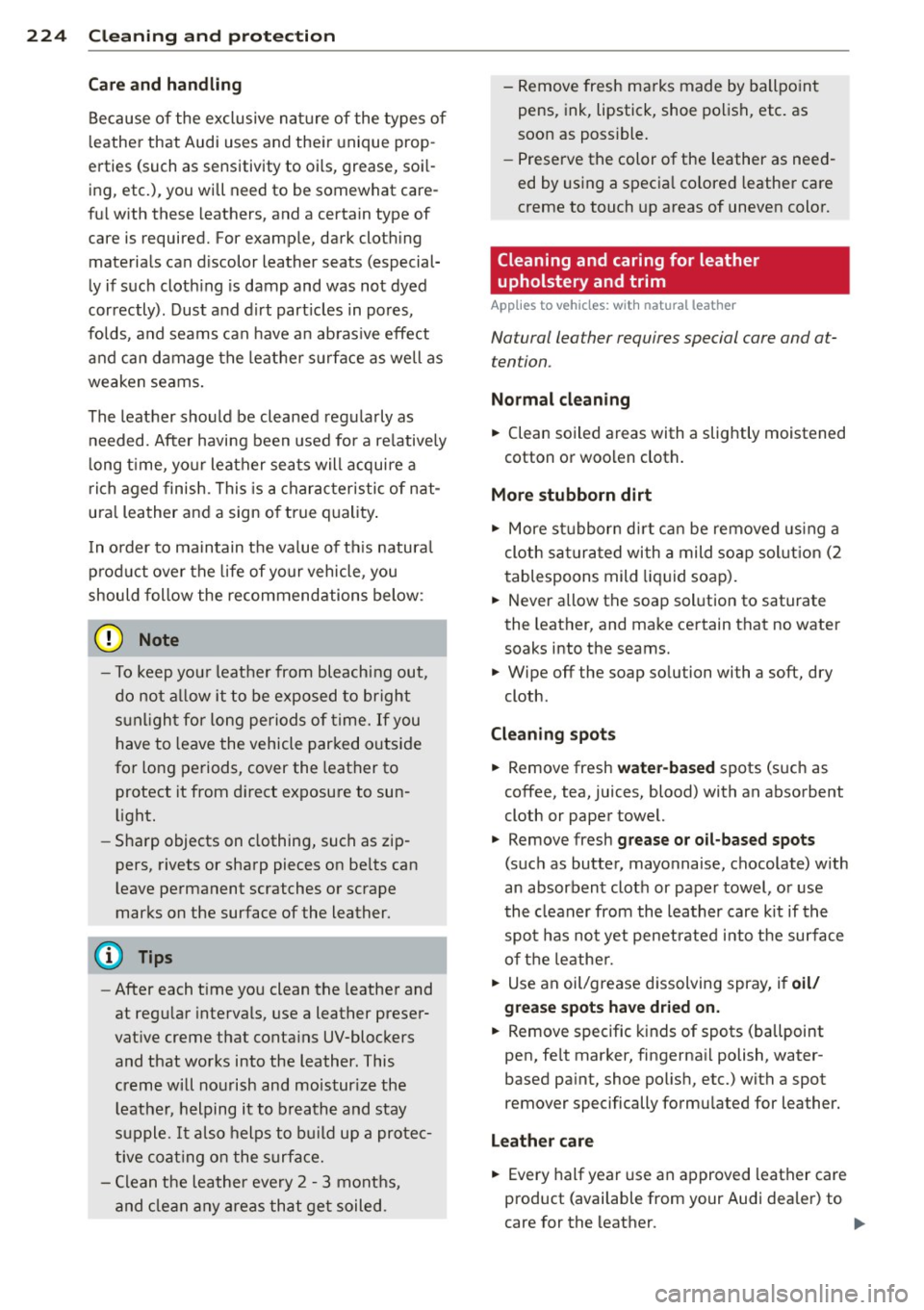
224 Cleaning and protection
Car e and handling
Because of the exclusive nat ure of the types of
l eather that Audi uses and their unique prop
erties (such as sensitivity to oils, grease, soi l
ing, etc.), you will need to be somewhat care
fu l w ith these leathers, and a certain type of
care is required. For examp le, dark clot hing
materials can d iscolor leather seats (especial
ly if such cloth ing is damp and was not dyed
correctly). Dust and dirt part icles in pores,
fo lds, and seams can have an ab ras ive effect
and can damage the leather s urface as well as
weaken seams.
The leather should be cleaned regularly as
n eeded. After having been used for a re latively
l ong t ime, yo ur leather sea ts will acqui re a
rich aged finish. This is a charac teris tic of nat
ura l leather and a sign o f true quality .
I n o rder to maintain t he va lue of t his natura l
p rod uct over the life of yo ur vehicle, you
should follow the recommendations below :
(D Note
-To keep you r leather from bleaching out,
do not a llow it to be exposed to br ight
sunl igh t for long periods of time. If you
have to leave the vehicle parked o utside
for long periods, cover the leather to
protect it from d irect exposure to sun
li ght.
- Sharp objects on clothing, such as zip
pers, rivets or sharp pieces on be lts can
l eave permanent scratches or scrape
marks on the surface of the leather.
- After each t ime you clean the leather and
at regu lar intervals, use a leather preser
vat ive creme that conta ins UV-blockers
and that works into the leather. This
creme wi ll nourish and moistur ize the
l eathe r, helping it to b reath e and stay
supple.
It also helps to b uild up a prote c
tive coat ing on the s urfa ce.
- Clean t he leather every 2 -3 mont hs,
and clean any areas that ge t soiled. - Remove
fresh marks made by ballpo int
pens, ink, lipstick, shoe polish, etc. as
soon as poss ible.
- Preserve the color of the leather as need
ed by using a specia l co lored leather care
creme to touch up areas of uneven color.
Cleaning and caring for leather
upholstery and trim
Applies to vehicles: with natural leather
Natural leather requires special care and a t
tention .
Normal cleaning
.. Clean soiled areas with a slightly moistened
cotton or woo len cloth .
More stubborn dirt
.. More s tubbor n dirt can be removed using a
clo th sa turated wi th a mild so ap solut ion (2
tablespoons mild liquid soap).
.. Never allow the soap sol ution to saturate
the leather, and make certain that no water
s oak s into the seam s.
.. Wipe off the soap so lution with a soft, dry
cloth .
Cleanin g spot s
.. Remove fresh water-based spots (s uch as
coffee, tea, juices, blood) with an absorbent
cloth or paper towel.
.. Remove fresh
grease or oil -based spots
(such as butte r, mayonnaise, chocolate) with
an absorbent clot h or paper towel, or use
the cleaner from the leather care kit if the
s po t h as no t yet penet rated i nto t he surface
of the leathe r .
.. Use an oil/grease d issolving spray, i f
oil/
grease spot s ha ve dr ied on.
.. Remove specific k inds of spots (ballpoint
pen, fe lt marker, fingerna il polish, water
based pa int, shoe po lish, etc.) with a spot
remover specifically formu lated for lea ther.
L e ather care
.. Every half year use an approved leather care
product (available from your Audi dealer) to
care for the leather . .,.
Page 227 of 318
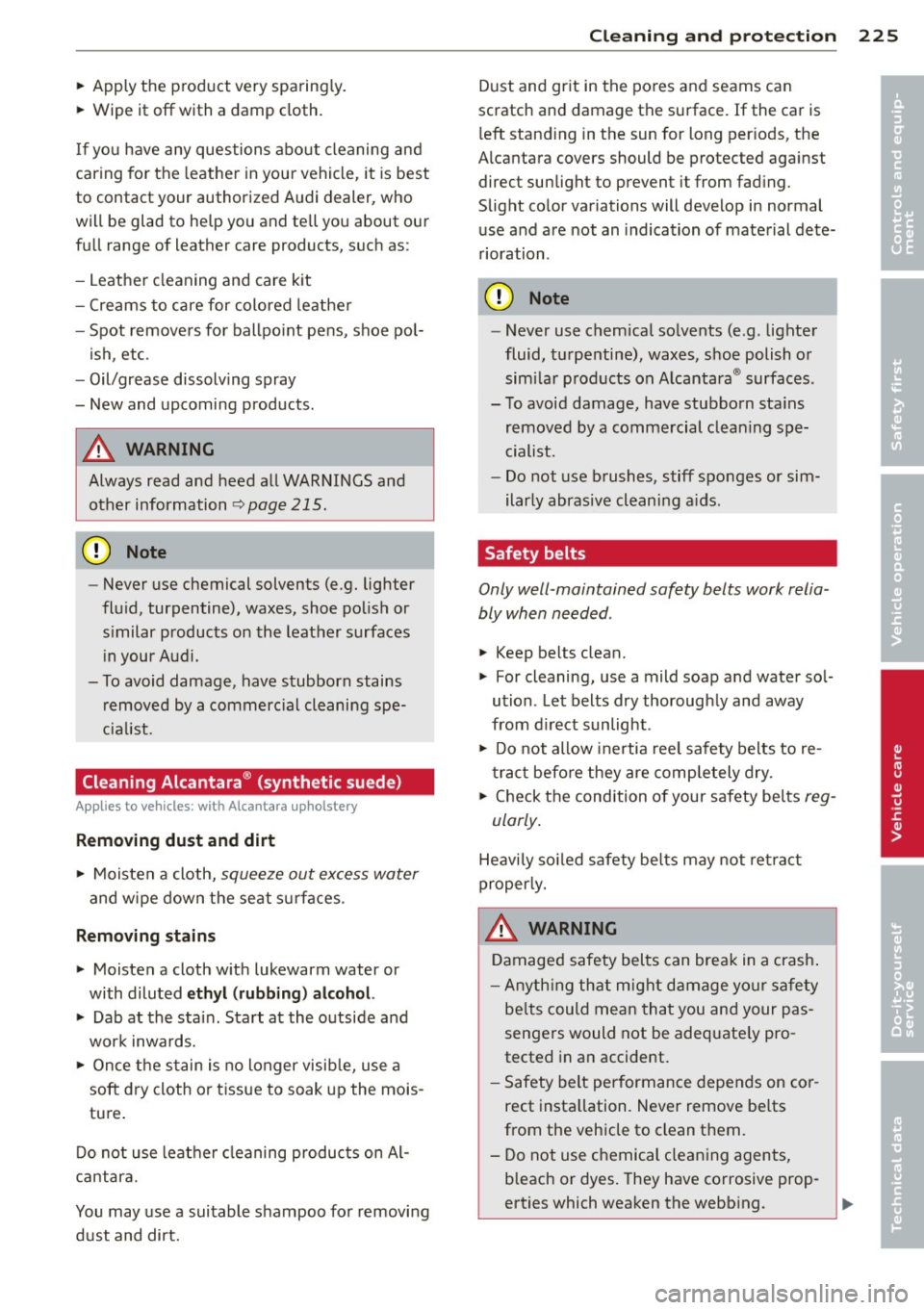
~ Apply the product very sparing ly .
~ Wipe it off with a damp cloth.
If you have any questions abo ut cleaning and
caring for the leather in your vehicle, it is best
to contact your authorized Audi dealer, who
will be glad to help you and tell you about our
fu ll range of leather care products, such as:
- Leather cleaning and care kit
- Creams to care for colored leathe r
- Spot removers for ballpo int pens, shoe pol-
ish , etc.
- Oil/grease dissolv ing spray
- New and upcoming products.
A WARNING
Always read and heed all WARNINGS and other information
~ page 215.
CD Note
- Never use chemical solvents (e.g. lighter
flu id, turpentine), waxes, shoe polis h or
s imilar products on the leather surfaces
i n your Audi.
- To avoid damage, have stubborn stains removed by a commerc ial cleani ng spe
cia list .
Cleaning Alcantara ® (synthetic suede)
Appl ies to vehicles : wit h Alcantara upholstery
Removing dust and dirt
~ Moisten a cloth, squeeze out excess water
and wipe down the se at su rfaces .
Removing stains
~ Moisten a cloth w ith lukewarm water or
with diluted ethyl (rubb ing) alcohol.
~ Dab at the stain. Start at the outside and
work inwa rds.
~ Once the s tain is no longer visib le, use a
soft d ry cloth or t issue to soak up the mois
tu re .
D o not use leather cleaning produc ts on Al
cantara.
You may use a suitable shampoo fo r removing
dust and dirt.
Cleaning and protec tion 225
D ust and gr it in the po res and seams can
scratch and damage th e surface. If the car is
l eft stand ing in the sun for long per iods, the
A lcantar a cover s should be protected aga inst
direct sunlight to prevent it from fad ing.
Slight co lor variations will develop in normal
use a nd are not an indication of mate rial dete
rioration .
CD Note
- Never use chemical so lvents (e.g . lighter
fluid, tu rpenti ne), waxes, shoe polish or
simi lar p roducts on A lcantara ® surfaces .
- T o avoid damage, have stubborn sta ins
removed by a comme rcial clean ing spe
cialist.
- Do not use b rushes, stiff sponges or sim
ilarly abrasive cleani ng a ids.
Safety belts
Only well -maintained safety belts work relia
bly when needed .
~ Keep belts clean.
~ For cleaning, use a mild soap a nd wate r so l
ution . Let belts dry thorough ly and away
from d irect sunlight .
~ Do not allow i nertia ree l safety belts to re
tract before they are comp letely dry.
~ Check t he condition of your safety belts reg
ularly .
Heavi ly so iled safety be lts may not ret ra ct
properly.
A WARNING ~
D amaged safety belts can break in a crash .
- Anyth ing th at m ight damage yo ur safety
be lts could mean tha t you and your pas
sengers would not be adequate ly pro
tected in an accident.
- Safety belt performance depends on cor
rect insta llation . Never remove be lts
from the vehicle to clean them.
- Do not use chemical cleaning agents,
b leach or dyes. They have corrosive prop
erties which weaken the webb ing .
•
•
Page 235 of 318

-Always disconnect the battery.
- Never smoke or work near heaters or open flames. Fluids in the engine com
partment could start a fire.
- Keep an approved fire extinguisher im
mediately available.
- To avoid electrical shock and personal in
jury while the engine is running or being
started, never touch :
- Ignition cables
- Other components of the high voltage
electronic ignition system.
- If you must perform a check or repair
with the engine running:
- First, fully apply the parking brake,
move selector lever to "P" (Park).
- Always use extreme caution to prevent
clothing, jewelry, or long hair from get
ting caught in the radiator fan, V-belts
or other moving parts, or from contact ing hot parts. Tie back hair before
starting, and do not wear clothing that
will hang or droop into the engine.
- Minimize exposure to emission and
chemical ha zards c:::> & .
A WARNING
California Proposition 65 Warning:
- Engine exhaust, some of its constituents,
and certain vehicle components contain
or emit chemicals known to the State of
California to cause cancer and birth de
fects and reproductive harm. In addition ,
certain fluids contained in vehicles and
certain products of component wear con
tain or emit chemicals known to the
State of California to cause cancer and
birth defects or other reproductive harm .
Checking and filling 233
-Battery posts, terminals and related ac
cessories contain lead and lead com
pounds, chemicals known to the State of
California to cause cancer and reproduc
tive harms. Wash hands after handling.
(D Note
When adding fluids, always make sure that
they are poured into the proper container
or filler opening, otherwise serious dam
age to vehicle systems will occur.
(® For the sake of the environment
To detect leaks in time, inspect the vehicle
floor pan from underneath regularly . If
you see spots from oil or other vehicle flu ids, have your vehicle inspected by an au
thorized Audi dealer.
Closing the engine hood
.,. Pull the hood down until the pressure from
the struts is reduced.
"' Let the hood
drop down and latch in place.
Do not try to push it shut; it may fail to en
gage
c:::> ,A .
A WARNING
-
A hood that is not completely latched
could fly up and block your view while driv
ing .
- When you close the engine hood, check it
to make sure the safety catch has proper ly engaged. The hood should be flush
with the surrounding vehicle body parts.
- If you notice while driving that the hood
is not secured properly , stop at once and
close it. •
•